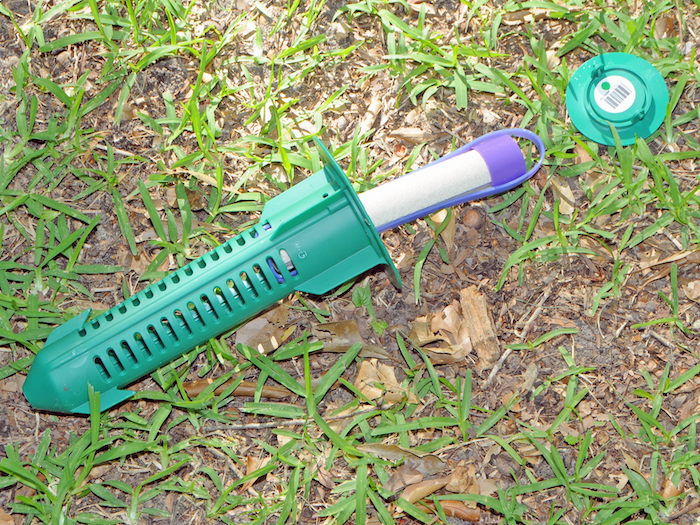Termite Bait Stations, Vol. 7, No. 10

In-ground termite bait stations are a relatively new method of termite control. More accurately, bait stations have been around a few decades, but their use has increased in recent years because of improvements. You may have seen bait stations installed around buildings without realizing what they were because all you can see is the round top, which is flush with the soil. The tops are four to six inches in diameter and vary in color depending on manufacturer and station style. Bait stations can even be installed into soil beneath concrete or asphalt. These are usually covered with metal tops. The photo shows what the part below ground looks like.
The concept for bait stations is simple. You put some insecticide-laced wood or other cellulose-based substrate that is attractive to termites in the ground; foraging termites feed on this bait, share it with nest mates, and the colony dies out. This works much like granular fire ant baits. As with fire ant baits, it is important that the insecticide be non-repellent and slow acting because you don’t want it to kill the foraging termite before it gets home with the groceries. Consequently, most active ingredients in termite baits are insect growth regulators, products that disrupt development when the termites molt and kill them then.
Bait stations are installed by drilling holes in the ground around the building, pressing the station into the ground, and inserting the bait. Depending on the brand, the bait may be wood or a cellulose-based bait matrix. Spacing of bait stations is important. Most manufacturers require stations be no farther than 20 feet apart, but closer spacing improves protection. Unlike soil-applied termiticides, bait stations must be inspected and maintained on at least an annual basis.
That sounds easy. Can I do this myself? Do-it-yourself termite control is not a good idea! Termite control is a long-term project. The goal is to keep termites from damaging your house for as long as you own it, and then to be able to sell a termite-free house to the next buyer. Some termite bait stations are available for sale to homeowners, and it only takes an afternoon to install these around the average house. It does sound easy. And cheaper. But it’s the “what ifs” that get you. What if you don’t maintain the stations properly? What if some stations are destroyed and not replaced? What if termites are able get in anyway and go undetected? What if Formosan termites establish aerial colonies and go undetected? Then the “what ifs” become “wish I hads!”
If you choose to use bait stations to protect your house from termites, hire a professional pest control company to install them, and to maintain them and inspect the building annually. Be sure to keep your termite contract in force by paying the annual renewal fee. Otherwise, you will no longer have effective termite protection. This is the key difference between baits and soil-applied termiticides. With the soil treatments, the termiticide remains in the soil and can continue to provide years of effective control even if you fail to renew the contract.
Though it is still best to keep the contract active for soil-applied treatments as well.
Do termite bait stations work? Are they really a viable alternative for termite control? Yes, when properly installed and maintained, bait stations can control termites indefinitely, giving a level of protection similar to that provided by soil-applied treatments. Both methods are highly effective and can provide long-term control, but there are pros and cons for each.
For more information on termites and termite control see Extension Publication 2568, Protect Your House from Termites and the MSU Termite Website.
Blake Layton, Extension Entomology Specialist, Mississippi State University Extension Service.
The information given here is for educational purposes only. Always read and follow current label directions. Specific commercial products are mentioned as examples only and reference to specific products or trade names is made with the understanding that no discrimination is intended to other products that may also be suitable and appropriately labeled.
Mississippi State University is an equal opportunity institution.
Bug’s Eye View is now on Facebook. Join the Bug's Eye View Facebook group here.

